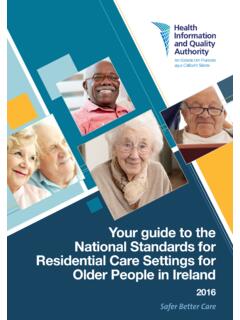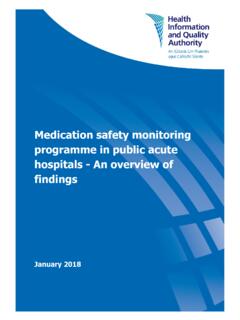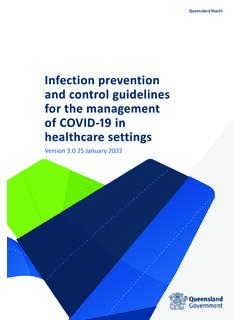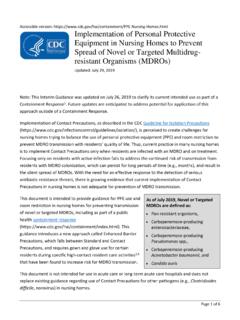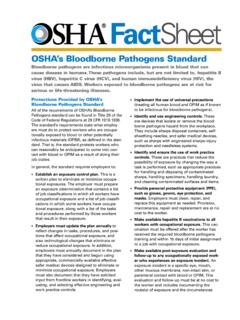Transcription of National Standards for the prevention and control of ...
1 National Standards for the prevention and control of healthcare - associated infections in acute healthcare services 2017. 1 Safer Better Care National Standards for the prevention and control of healthcare - associated infections in acute healthcare services Health Information and Quality Authority Note on terms and abbreviations used in these Standards A full range of terms and abbreviations used in these Standards is contained in a glossary at the end of this report. Page 2 of 120. National Standards for the prevention and control of healthcare - associated infections in acute healthcare services Health Information and Quality Authority About the Health Information and Quality Authority The Health Information and Quality Authority (HIQA) is an independent authority established to drive high-quality and safe care for people using our health and social care services in Ireland.
2 HIQA's role is to develop Standards , inspect and review health and social care services and support informed decisions on how services are delivered. HIQA aims to safeguard people and improve the safety and quality of health and social care services across its full range of functions. HIQA's mandate to date extends across a specified range of public, private and voluntary sector services. Reporting to the Minister for Health and the Minister for Children and Youth Affairs, HIQA has statutory responsibility for: Setting Standards for Health and Social Services Developing person- centred Standards , based on evidence and best international practice, for health and social care services in Ireland. Regulation Registering and inspecting designated centres. Monitoring Children's Services Monitoring and inspecting children's social services.
3 Monitoring healthcare Safety and Quality Monitoring the safety and quality of health services and investigating as necessary serious concerns about the health and welfare of people who use these services. Health Technology Assessment Providing advice that enables the best outcome for people who use our health service and the best use of resources by evaluating the clinical effectiveness and cost effectiveness of drugs, equipment, diagnostic techniques and health promotion and protection activities. Health Information Advising on the efficient and secure collection and sharing of health information, setting Standards , evaluating information resources and publishing information about the delivery and performance of Ireland's health and social care services. Page 3 of 120. National Standards for the prevention and control of healthcare - associated infections in acute healthcare services Health Information and Quality Authority Page 4 of 120.
4 National Standards for the prevention and control of healthcare - associated infections in acute healthcare services Health Information and Quality Authority Table of contents Note on terms and abbreviations used in these Standards .. 2. About the Health Information and Quality Authority .. 3. 6. 1. Overview .. 6. 2. Background .. 7. 3. Purpose of the National Standards .. 8. 4. Scope of the National Standards .. 9. 5. Themes in the National Standards .. 9. 6. Structure of the National Standards .. 11. 7. Monitoring compliance with the National Standards .. 12. 8. Key terms used in the National Standards .. 13. 9. How the National Standards were developed .. 15. Summary of the National Standards for the prevention and control of healthcare - associated infections in acute healthcare services .. 16. Theme 1. Person-centred Care and Support.
5 20. Theme 2. Effective Care and Support .. 24. Theme 3. Safe Care and Support .. 44. Theme 4. Better Health and Wellbeing .. 59. Theme 5. Leadership, Governance and 63. Theme 6. Workforce .. 74. Theme 7. Use of Resources .. 80. Theme 8. Use of Information .. 84. Glossary of terms and abbreviations .. 88. 107. Appendix 1 Membership of the Standards Advisory Group convened by HIQA .. 117. Page 5 of 120. National Standards for the prevention and control of healthcare - associated infections in acute healthcare services Health Information and Quality Authority Introduction 1. Overview Preventing and controlling healthcare - associated infections continues to be a significant challenge to healthcare systems throughout the world, including Ireland. These infections affect on average 1 in 20 people in the acute healthcare service setting, rising in patient care areas with high numbers of vulnerable patients and complex activity.
6 In addition, antimicrobial resistance presents a serious threat to patients, with an increasing amount of outbreaks related to multidrug-resistant organisms reported in Irish hospitals. In particular, resistant enterobacteriaceae and enterococci have emerged as important causes of healthcare - associated infection. In 2014, Ireland had the highest proportion of vancomycin-resistant Enterococci blood-stream infection in Europe. The potential risk of transmission and spread of healthcare - associated infection has been observed with increased patient transfer occurring between hospitals in Ireland. healthcare - associated infections can have a huge impact on patients and their families, causing serious illness, long-term disability and death. There are also significant impacts on acute healthcare services due to the cost implications of such infections , including prolonged patient stays, isolation requirements and ward closures.
7 However, a significant proportion of healthcare - associated infection is known to be avoidable, if effective structures, systems and processes are in place to manage the potential risks arising from the environment and activities within the hospital. This is best achieved through a well-organised, planned and managed infection prevention and control programme which is integrated with an antimicrobial stewardship programme to effectively coordinate efforts within an acute healthcare service. Measures that prevent infection in the first instance and reduce the spread of micro- organisms are essential. Effective prevention and control of healthcare - associated infections requires a multi-targeted approach, as no single practice is responsible for reducing the risk of infection. This depends on everyone working within the service understanding their responsibilities and engaging in behaviours that are well known to reduce the risk of infection, such as effective hand hygiene and providing a clean environment.
8 Hospitals must have the necessary resources in place to meet their infection prevention and control needs and priorities.. HSE Health Protection Surveillance Centre. Point Prevalence Survey of Hospital-Acquired infections &. Antimicrobial Use in European Acute Care Hospitals: May 2012. Republic of Ireland National Report; 2012.. HSE Health Protection Surveillance Centre. Annual Epidemiological Report. 2014; (9): pp156-170. Page 6 of 120. National Standards for the prevention and control of healthcare - associated infections in acute healthcare services Health Information and Quality Authority healthcare - associated infections and antimicrobial resistance are also a significant problem in the wider community. Hospitals need to engage in more strategic efforts with primary and community health and social care services, in order to reduce these infections locally.
9 The timely sharing of information about healthcare - associated infection incidents and outbreaks is critical for all services to manage their risk of infection effectively. Acute service providers also have an opportunity to work with their primary and community care colleagues to collectively target common reoccurring infection prevention and control problems. There is significant scope for improved integrated efforts between all healthcare services, but this needs the necessary National operational structures in place to prevent and control healthcare - associated infections across the entire healthcare system. 2. Background These draft Standards are a revision of the previously published National Standards for the prevention and control of healthcare associated infections (2009) and provide a framework for service providers to assess and improve infection prevention and control practices.
10 The general content of the 2009 Standards is retained, updated and streamlined within the document. Previously stated criteria within those 2009 Standards have been developed into stand-alone Standards in relation to: incident identification and management monitoring occupational health services externally contracted service providers resources information governance. Certain Standards have been strengthened, including communication with the patient; local, regional and National governance structures; and workforce training. New Standards include those covering: cleaning and decontamination of equipment decontamination of reusable invasive medical devices risk management quality improvement health and wellbeing of patients procurement of medical devices and equipment management of information. Page 7 of 120. National Standards for the prevention and control of healthcare - associated infections in acute healthcare services Health Information and Quality Authority The Standards are presented in the new format that has been adopted by HIQA for all Standards that it develops for health and social care services.





